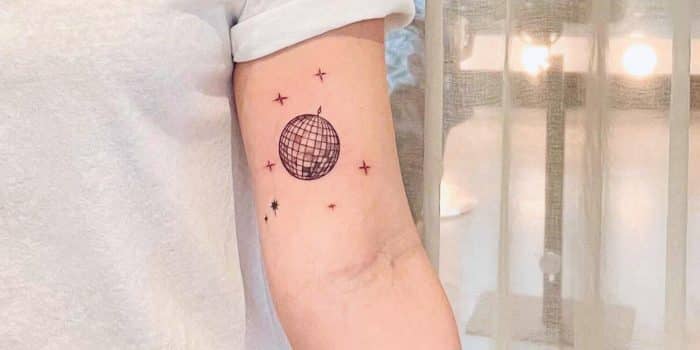I’m no stranger to tattoo regret. At 18, I walked into a tattoo studio on my college campus, asked for a horse on the back of my neck, and accepted a basic design the artist pulled off Google. I knew, the moment the needle hit my skin, that I was making a mistake. It was one of those paralyzing moments, similar to when the manicurist applies the first coat of polish and you hate the color but stay silent, not wanting to be difficult. Only I couldn’t wipe away the solid-black, misshapen horse with acetone.
Years later, working as a beauty editor, I jumped at the opportunity to remove it. Around 10 laser sessions later, there’s still a faint outline and some hypopigmentation. Meanwhile, I kept getting more—delicate script across my arm and rib; the female sign on my wrist; lips behind my ear, because I couldn’t turn down a free tattoo by Jonboy at a lipstick launch party; some stars. They’re all perfectly fine, and perhaps I should’ve stopped there.
Instead, I did something crazy, at the height of my boredom during the pandemic: I bought a tattoo machine. [Insert lecture here about the dangers of improper sterilization practices and why self-tattooing isn’t a good idea.] I taught myself the basics about needle types and voltage settings and practiced designs on oranges while watching the Real Housewives. A few weeks later, I inked some (ugly) little hearts and a (decent) flower on my feet. It was an itch I’d needed to scratch, I guess; I won’t be doing it again.
All of that is to say, I was excited when I first heard about Ephemeral Tattoo—a studio that opened in Brooklyn, New York, in March of this year and offers first-of-its-kind semipermanent ink. It’s applied exactly like a regular tattoo (meaning it hurts just the same, if that’s a concern to you), only it disappears in 9–15 months. “Regret nothing” is the promise Ephemeral makes, so I figured I might as well get the disco ball I’ve always wanted but now have enough foresight to know won’t look so whimsical in my AARP years.
After making an appointment, I filled out a form that explained that line designs and shading with lines (etching) or dots (stippling) look best in the fading process. It showed examples of different styles and asked me to choose my favorites, then to submit inspiration photos and detail what I wanted to get, and where, on my body.
When I got to the studio, which is filled with sunlight and plants and millennial furniture, my tattoo artist, Anastasia, showed me the disco ball she’d sketched out in different sizes. It was exactly what I’d envisioned, and I decided to put it on my inner arm, where I already had a couple of stars. I’ve always been too nervous to get a big design in a visible place, but I decided to trust that it really would fade to nothing.
An hour and a half later, my design was finished. Anastasia took a few photos before someone came in to put a hydrocolloid (HC) patch on my arm, explain the healing process (it takes four to six weeks, during which time there may be redness, scabbing, and itchiness, and you can’t submerge it in water, outside of showering), and leave me with a kit containing soap, ointment, and hydrocortisone cream.
I’ve had my tattoo for two weeks now, and while it’s a good conversation starter, it doesn’t quite feel like me—I think I’m made for a bunch of small, delicate designs versus something this size. I’m ready for a fun summer with my disco ball, but I’m glad the party won’t last forever, which is exactly the point.

Below, cofounder Josh Sakhai explains more about how Ephemeral Tattoo came to be, how the ink works, and the company’s expansion plans.
RealSelf: What was the inspiration behind Ephemeral Tattoo?
Josh Sakhai: We decided to start Ephemeral Tattoo after our former team member had to go through the painful ordeal of getting his permanent tattoos removed. This sparked an epiphany: What if ink were made to fade? The full tattoo experience, minus the permanence.
Ephemeral was an opportunity to address this question and redirect the future of the industry by creating a new category of tattoos—expanding the industry to make it more inclusive and approachable to everyone, including those who were previously turned off by the idea of permanence. Our entire Ephemeral journey is centered around giving an authentic tattoo experience, without any of the intimidation or pressure.
RS: How did you discover that ink that lasts only a year could be possible?
JS: The ink was developed by my fellow Ephemeral cofounders, Vandan Shah and Brennal Pierre [both have Ph.D.s in chemical engineering], over the past six years, and it has since been tested by all three of us—as in, we tested the ink on our own skin!—with more than 50 ink formulations.
Ephemeral’s ink is made of medical-grade, bioabsorbable, and biocompatible polymers, with carefully chosen, high-quality pigments that are routinely used in foods, cosmetics, and other products. Our biggest challenge was to actually get the ink to last a full year. Our initial formulas faded more quickly than we wanted, so we spent six years working to increase the longevity of the ink to a year.
After we had developed and tested the formulation on ourselves, we also partnered with a leading dermatologist to initiate an institutional review-board-approved clinical trial, to scientifically validate the safety and efficacy of the ink.
RS: Okay, but how does the ink actually work?
JS: To understand how Ephemeral ink works, it’s helpful to distinguish why permanent tattoos are permanent. A permanent tattoo uses ink that goes into the dermis—the layer just below the outer skin—administered via needle by a trained tattoo artist. The thing that makes permanent tattoos permanent is your body’s inability to break down the dye. Traditional ink clumps together, too large to be removed. Your body “walls off” the area, and the ink stays.
In contrast, Ephemeral ink particles break down over time and become small enough to be removed by the body. The rate at which this happens varies from person to person.
Ephemeral tattoos are applied by real tattoo artists, with real tattoo machinery. Like traditional tattoos, Ephemeral tattoos are applied through an intrusive process in which the ink is being applied into the dermis layer by breaking open the skin.
RS: Does it always fade evenly, or will it look splotchy?
JS: Fading looks a bit different on everyone, since everyone’s skin is unique. The way Ephemeral fades depends on your skin type, where it is applied, and if it’s correctly cared for.
RS: Does the tattoo really disappear completely, with no trace outline left behind?
JS: Our six years of research and development can attest that Ephemeral tattoos fade completely over 9–15 months, but the exact amount of time varies by person, depending on their unique skin type, the type of tattoo, and its placement.
However, after the ink fades away, there is a possibility that the skin’s pigment may look lighter or darker in the area. This is a result of the tattoo process itself. Ephemeral tattoos, just like permanent ones, cause trauma to the skin, and this slight difference in pigmentation is a result of the skin’s healing process. [Editor’s note: people with skin tones of IV or higher on the Fitzpatrick scale tend to be more prone to develop hyper- or hypopigmentation.]
RS: If you like the tattoo and don’t want it to fade, can you go over it with regular, permanent ink?
JS: Yes! You can absolutely go over it with permanent ink or Ephemeral ink, after six months of your original tattoo. That gives the skin enough time to heal.
RS: How much does an Ephemeral tattoo cost?
JS: Depending on your design, a tattoo with one of our top-tier artists will be between $175 and $450. The final price depends on the exact design you want and is determined in-studio, before any ink goes into your skin.
In response to folks who think Ephemeral should be cheaper, we actually see the fact that our tattoos are made to fade as a premium. We believe that our price reflects the years of novel scientific research that went into developing a first-of-its-kind product. Not only that, but the price also supports our world-class studio experience and allows us to offer quality-of-life and financial stability to our artists. [At Ephemeral, tips are already built into the price.]
RS: Where can people get an Ephemeral tattoo outside of New York City?
JS: We view Ephemeral as a global brand, and we are committed to realizing our vision of a world where every body is a canvas for limitless self-expression. To realize this vision, we need to be where our customers are! So yes, we are planning to open other studios outside NYC. If you want Ephemeral to open up in your city, give us a shout on Instagram and sign up for our mailing list.











